Balsalazide
- CAS NO.:80573-04-2
- Empirical Formula: C17H15N3O6
- Molecular Weight: 357.32
- MDL number: MFCD00868204
- EINECS: 617-116-8
- SAFETY DATA SHEET (SDS)
- Update Date: 2024-12-18 14:15:30
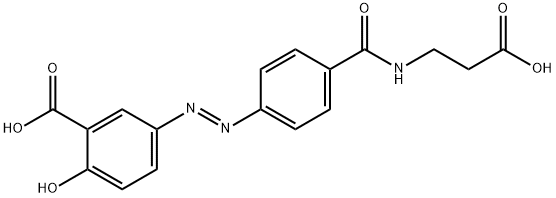
What is Balsalazide?
Absorption
Low and variable, intact balsalazide is poorly absorbed systemically.
Toxicity
A single oral dose of balsalazide disodium at 5 grams/kg or 4-aminobenzoyl-(beta)-alanine, a metabolite of balsalazide disodium, at 1 gram/kg was non-lethal in mice and rats. No symptoms of acute toxicity were seen at these doses.
Description
Balsalazide is a prodrug form of 5-aminosalicylic acid (5-ASA; ). It is cleaved by bacterial azoreductases in the intestinal lumen to release 5-ASA. Balsalazide (600 mg/kg per day) decreases IL-2 levels and increases IL-6 levels in the serum and colonic mucosa membrane, as well as decreases micro- and macroscopic colonic damage, in a rat model of colitis induced by 2,4-dinitrochlorobenzene (DNCB). Formulations containing balsalazide have been used in the treatment of ulcerative colitis.
Description
Colazide was launched in the UK for mild to moderate acute attacks of ulcerative colitis. It can be prepared by diazotization of 3-(4-aminobenzoylamino) propionic acid followed by condensation with salicylic acid. Colazide, an analogue of sulfasalazine, was found to be non-toxic and non-mutagenic in the Ames test. Once ingested the molecule releases a non-toxic fragment, 4-aminobenzoyl-β-alanine (poorly absorbed - 75% excretion in stool), and the active component 5- aminosalicylic acid (Mesalazine). The exact mechanism of action is not clearly understood but it is cytoprotective and has antiinflammatory properties. Other biological effects have been observed and include the following: (a) granulocyte activation is blocked, (b) there is a reduction in myeloperoxidase activity, and (c) a reduction in the release of arachidonic acid with a concomitant decrease in prostaglandin and leucotriene (as indicated by the lack of production of LTB4) production. It can behave as a reactive oxygen species (ROS) scavenger, inhibit PAF formation, reduce IL-1 production, and antagonize TNF and NK cells. While comparable in efficacy to sulfasalazine, Colazide removes the possibility of sulfasalazine side-effects, such as, agranulocytosis, hepatotoxicity and male infertility.
Chemical properties
Yellow Solid
Originator
Biorex (UK)
The Uses of Balsalazide
Balsalazide-d4 is an isotopically labelled analog of Balsalazide (B116300), which is an analogue of Sulfasalazine (S699084). A prodrug of 5-aminosalicylic acid where carrier molecule is 4-aminobenzoyl-β-alanine. Anti-inflammatory (gastrointestinal).
The Uses of Balsalazide
An analogue of Sulfasalazine, A prodrug of 5-Aminosalicylic Acid
What are the applications of Application
Balsalazide is an analogue of Sulfasalazine
Background
Balsalazide is an anti-inflammatory drug used in the treatment of Inflammatory Bowel Disease. It is sold under the name "Colazal" in the US and "Colazide" in the UK.
The chemical name is (E)-5-[[-4-(2-carboxyethyl) aminocarbonyl] phenyl]azo] -2-hydroxybenzoic acid. It is usually administered as the disodium salt.
Balsalazide works by deliverying mesalazine to the large intestine to act directly on ulcerative colitis. Mesalazine is also known as 5-aminosalicylic acid, or 5-ASA.
Indications
For the treatment of mildly to moderately active ulcerative colitis.
Definition
ChEBI: A monohydroxybenzoic acid consisting of 5-aminosalicylic acid (mesalazine) linked to 4-aminobenzoyl-beta-alanine via an azo bond.
Manufacturing Process
125 g finely powdered 4-nitrobenzoyl chloride were added portionwise, while
stirring, to a solution of 70 g β-alanine in 500 ml water containing 65 g
sodium hydroxide and cooled to 5°C. The reaction mixture was stirred for 3
hours and then added to a mixture of ice and hydrochloric acid. The
precipitate obtained was filtered off, washed with water and dried by suction.
After crystallisation of the dried product from hot acetone, there were
obtained 130 g 4-nitrobenzoyl-β-alanine, M.P. 164°-166°C.
A suspension of 15 g finely powdered 4-nitrobenzoyl-β-alanine in 200 ml
ethanol was stirred in an atmosphere of hydrogen in the presence of 1 g of
palladium-charcoal (5%), while cooling gently. When the absorption of
hydrogen had ceased, the reaction mixture was filtered and the filtrate
concentrated to a small volume. Upon adding diethyl ether and cooling 4-
aminobenzoyl-β-alanine was obtained. The yield was 11.5 g, M.P. 156°-158°C.
8.8 g 4-aminobenzoyl-β-alanine were triturated with 12 ml hydrochloric acid
and the paste obtained was dissolved in 100 ml water. The solution was
cooled to -5°C and a solution of 3 g sodium nitrite in 20 ml water, cooled to
0°C, was added dropwise, while stirring. The diazotised solution was left for 1
hour at 0°C and was then added dropwise at -5°C to a solution of 6 g salicylic
acid in 70 ml water containing 3.6 g sodium hydroxide and 7 g sodium
carbonate. The final reaction mixture was adjusted to a pH of about 8, stirred
for 2 to 3 hours and added to a mixture of dilute hydrochloric acid and ice.
The precipitate obtained was filtered off, washed with water and suction dried.
Crystallisation from hot ethanol gave 11.9 g 5-[(2-carboxy-ethylcarbamoyl)-
phenylazo]-2-hydroxy-benzoic acid, M.P. 254°-255°C.
10.7 g of the free acid were dissolved in 300 ml warm ethanol and treated
with a solution of 2.4 g sodium hydroxide in 25 ml ethanol. The precipitate
obtained was filtered off, washed with ethanol and diethyl ether and dried in a
vacuum at 50°C to give 11.5 g of the disodium salt of 5-[(2-carboxyethylcarbamoyl)-
phenylazo]-2-hydroxy-benzoic acid, M.P. >350°C.
brand name
Colazal (Salix).
Therapeutic Function
Antiinflammatory
Pharmacokinetics
Balsalazide is a prodrug that has little or no pharmacologic activity until it is enzymatically cleaved in the colon to produce mesalamine (5-aminosalicylic acid), an anti inflammatory drug indicated for the treatment of mildly to moderately active ulcerative colitis. Balsalazide disodium is delivered intact to the colon where it is cleaved by bacterial azoreduction to release equimolar quantities of mesalamine, which is the therapeutically active portion of the molecule, and the intert 4-aminobenzoyl-(beta)-alanine. As a result, the spectrum of pharmacologic activity of balsalazide is similar to that of mesalamine.
Clinical Use
Treatment and maintenance of remission, in mild to moderate ulcerative colitis
Metabolism
Cleaved in the colon via bacterial azoreduction to 5–aminosalicylic acid (5–ASA) and 4–aminobenzoyl-beta-alanine, the inactive carrier moiety.
Metabolism
Very little of an oral dose of balsalazide is absorbed via the upper gastrointestinal tract, and almost the entire dose reaches its site of action in the colon intact. It is broken down by the colonic bacterial flora into 5-aminosalicylic acid (mesalazine), which is active, and 4-aminobenzoylalanine, which is considered to be an inert carrier. Most of a dose is eliminated via the faeces, but about 25% of the released mesalazine is absorbed and acetylated. A small proportion of 4-aminobenzoylalanine is absorbed and acetylated by first-pass metabolism through the liver. The acetylated metabolites are excreted in the urine.
Properties of Balsalazide
| Melting point: | 254-255?C |
| Boiling point: | 729.6±60.0 °C(Predicted) |
| Density | 1.44±0.1 g/cm3(Predicted) |
| vapor pressure | 0Pa at 20℃ |
| storage temp. | -20°C Freezer |
| solubility | DMSO (Slightly), Methanol (Slightly) |
| form | Solid |
| pka | 2.97±0.10(Predicted) |
| color | Yellow to Beige |
| EPA Substance Registry System | Benzoic acid, 5-[(1E)-2-[4-[[(2-carboxyethyl)amino]carbonyl]phenyl]diazenyl]-2-hydroxy- (80573-04-2) |
Safety information for Balsalazide
Computed Descriptors for Balsalazide
New Products
Tert-butyl bis(2-chloroethyl)carbamate 4-Methylphenylacetic acid N-Boc-D-alaninol N-BOC-D/L-ALANINOL N-octanoyl benzotriazole 3-Morpholino-1-(4-nitrophenyl)-5,6-dihydropyridin- 2(1H)-one Furan-2,5-Dicarboxylic Acid DIETHYL AMINOMALONATE HYDROCHLORIDE 1,1’-CARBONYLDIIMIDAZOLE R-2-BENZYLOXY PROPIONIC ACID 1,1’-CARBONYLDI (1,2-4 TRIAZOLE) N-METHYL INDAZOLE-3-CARBOXYLIC ACID (2-Hydroxyphenyl)acetonitrile 4-Bromopyrazole 5-BROMO-2CYANO PYRIDINE 5,6-Dimethoxyindanone 5-broMo-2-chloro-N-cyclopentylpyriMidin-4-aMine 2-(Cyanocyclohexyl)acetic acid 4-methoxy-3,5-dinitropyridine 1-(4-(aminomethyl)benzyl)urea hydrochloride 2-aminopropyl benzoate hydrochloride diethyl 2-(2-((tertbutoxycarbonyl)amino) ethyl)malonate tert-butyl 4- (ureidomethyl)benzylcarbamate Ethyl-2-chloro((4-methoxyphenyl)hydrazono)acetateRelated products of tetrahydrofuran


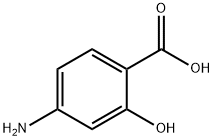
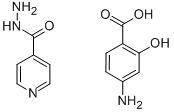

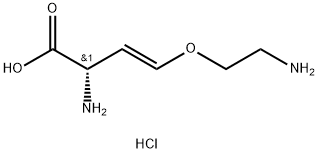
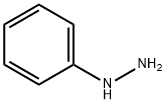
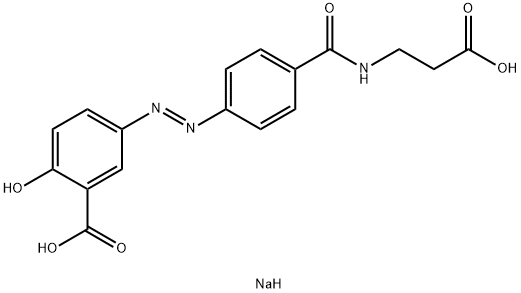
You may like
-
 Balsalazide 98%View Details
Balsalazide 98%View Details -
 Balsalazide 98% (HPLC) CAS 80573-04-2View Details
Balsalazide 98% (HPLC) CAS 80573-04-2View Details
80573-04-2 -
 1975-50-4 98%View Details
1975-50-4 98%View Details
1975-50-4 -
 2-HYDROXY BENZYL ALCOHOL 98%View Details
2-HYDROXY BENZYL ALCOHOL 98%View Details
90-01-7 -
 2-Chloro-1,3-Bis(Dimethylamino)Trimethinium Hexafluorophosphate 221615-75-4 98%View Details
2-Chloro-1,3-Bis(Dimethylamino)Trimethinium Hexafluorophosphate 221615-75-4 98%View Details
221615-75-4 -
 14714-50-2 (2-Hydroxyphenyl)acetonitrile 98+View Details
14714-50-2 (2-Hydroxyphenyl)acetonitrile 98+View Details
14714-50-2 -
 118753-70-1 98+View Details
118753-70-1 98+View Details
118753-70-1 -
 733039-20-8 5-broMo-2-chloro-N-cyclopentylpyriMidin-4-aMine 98+View Details
733039-20-8 5-broMo-2-chloro-N-cyclopentylpyriMidin-4-aMine 98+View Details
733039-20-8